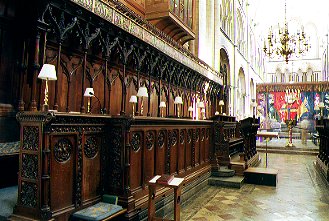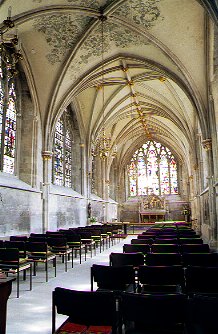Tour and History of Chichester Cathedral

The cathedral was built in Chichester as a result of the Norman policy of centralising Sees in population and administrative centres rather than in less accessible rural areas. An earlier cathedral had existed near Selsey, founded by Saint Wilfrid at the end of the seventh century, during his period of exile in Sussex.
The building of the new cathedral in the centre of the former Roman town, began in around 1076 under bishop Stigand who had been the last Bishop of Selsey. Construction continued into the twelfth century, and by 1108 Bishop Ralph Luffa was able to dedicate the building. Following a fire in 1114, Bishop Luffa restored the building and extended it westwards.

A further fire in 1187 completely destroyed the timber roof and caused extensive damage to the arcade stonework. Restoration included the introduction of stone vaulting, supported on the inside by stone shafts from floor to ceiling and the addition of Purbeck marble shafts at ground and clerestory level; externally, flying buttresses were added. At this time, the retro-choir was completely restyled, squaring off the previously apsidal east end, and introducing the use of pointed arches into the triforium and clerestory arches. Composite columns of Purbeck marble were substituted for the Norman stone piers. Re-dedication took place in 1 199, though it is probable that building work had not been completed by then.
During the thirteenth century, chapels were added to the nave aisles forming an unusual architectural feature, and making Chichester one of the widest English cathedrals. One of the most important events in the Cathedral's history took place in 1262 when Bishop Richard, who had died only nine years earlier, was canonized by Pope Urban 'IV. This event was followed in 1276 by the translation of his body from its original burial place in the Chapel of St Thomas and St Edmund, to a Shrine in the Retro-choir, which became an important centre for pilgrimage.

The fourteenth century saw the completion of the extension of the Lady Chapel containing windows in the 'decorated' style: In the early fourteenth century Bishop John Langton completely rebuilt the south wall of the South Transept creating a large seven light window with elaborate tracery around a curvilinear triangle. The Canons' Vestry was also built around this time, and the Chapter House, which is also used as the Song School, was added immediately overhead, about one hundred years later.
During the fifteenth century, important features were added to the Cathedral which greatly altered its external appearance: the cloisters, enclosing the south transept; the detached bell-tower, the only one of its kind remaining in England and, which today houses a peal of eight bells; and the spire, so greatly admired by Pevsner - the "spire and countryside form an equation or a symbol experienced by millions of people every year, which cannot be given a value purely in terms of landscape or "architecture".
Bishop Robert Sherburne was an important influence on Chichester in the early years of the sixteenth century. He introduced measures to improve the effectiveness of the clergy and the ability of the choir to perform the daily offices, and he adorned the Cathedral with the paintings of Lambert Barnard.
The Reformation brought considerable destruction to the Cathedral. Brasses were removed from memorials and many stone figures and carvings were defaced: the shrine of St Richard was totally destroyed. Further damage to the Cathedral and its contents, notably the library, took place at the hands of Parliamentary troops when they took possession of the city at the end of 1642.
Following what must be described as many years of neglect, the restoration of the Cathedral was started in earnest by Dean George Chandler during the 1840s. His successor, Dean Walter Farquhar Hook, had to deal with a major setback to the restoration programme when the spire collapsed in 1861: the spire we see today is Sir George Gilbert Scott's restoration.
A great deal has been achieved at Chichester in recent years to ensure that the structure of the Cathedral is in good order. The interior stonework has recently been thoroughly cleaned, the ceilings restored and their beauty enhanced by the installation of up-lighting, a gift by the Friends of the Cathedral. However, important restoration work remains to be carried out.
FURNISHINGS
Among features of particular interest are the Chichester Reliefs, two carved stone panels depicting part of the story of the raising of Lazarus. Dating from the early twelfth century, they are regarded as outstanding examples of pregothic sculpture.
The choir stalls embody-misericords dating from around 1330, though much of the panelling and upper work of the stalls dates from nineteenth century restoration.
Sixteen century paintings by Lambert Barnard of past bishops and the Kings and Queens of England enlighten the transepts: fragments of his ceiling paintings have also survived.
The Cathedral TREASURY contains a display of church plate, furnishings and vestments from many parishes in the diocese as well as the Cathedral's own collection.
The LIBRARY was despoiled during the Civil War. The present collection of books is based on bequests from generous donors from the Restoration onwards and contains interesting volumes from Bishop Henry King's [1642-691 library, as well as some important medieval manuscripts.
Among the many interesting monuments in the Cathedral, including seven by John Flaxman, is the fourteenth century table tomb on which lie the effigies of Richard Fitzalan III, thirteenth Earl of Arundel, and his second wife Eleanor holding hands. This is the tomb which inspired the poet, Philip Larkin, to write his poem, "An Arundel Tomb".
MODERN ART
One of the distinguishing features of Chichester is the use of modern works of art to invigorate and beautify the Cathedral. This idea, initiated by Bishop George Bell, was largely put into effect by Walter Hussey during his deanship between 1955-77.
Works to be seen in the Cathedral include:
PAINTINGS
'The Baptism of Christ' by Hans Feibusch (1951), 'Noli me Tangere' by Graham Sutherland (1960), 'Baptism' by Patrick
Procktor (1984)
TAPESTRIES
By John Piper as a reredos to the high altar (1966), and Ursula Benker-Schirmer in the retro-choir (1985).
STAINED GLASS
A window by Marc Chagall, based on the theme of Psalm 150 '...let everything that hath breath praise the Lord' (1978).
EMBROIDERIES
A panel behind the Bishop's throne designed by Joan Freeman (1993); hassocks in the Presbytery (1995): and, recently, new altar rail kneelers and cushions for the dignitaries' stalls, designed by Sylvia Green (1999) All were worked by members of the Cathedral's Seffrid Guild.
CAST ALUMINIUM WORK by Geoffrey Clarke
FONT
In polished polyphant stone and beaten copper by John Skelton (1983)
ALTARS
In the retro-choir, St Mary Magdalene's Chapel and the high altar by Robert Potter
SCULPTURES
'Virgin and Child' by John Skelton (1988), 'Christ in Judgement' by Philip Jackson (1998)